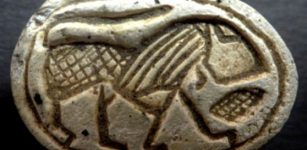Mystery Of Queen Semiramis: Famous And Powerful Ancient Ruler And Warrior Queen
Ellen Lloyd - AncientPages.com - Queen Semiramis was one of the most interesting, famous, and powerful figures in ancient history and yet, her life is shrouded in mystery because very little is known about this ancient warrior queen.
Queen Semiramis (Sammu-Ramat) was the legendary wife of King Ninus, succeeding him to the throne of Assyria and she ruled the Assyrian Empire between 811-806 B.C.
Her achievements and influence made her a controversial, famous and power ancient ruler. Ancient places in Assyria, Mesopotamia, Asia Minor, Arabia, and the Caucasus were named after her.
Even in the Middle Ages, and an old name of the Armenian city of Van was Shamiramagerd (in Armenian it means created by Semiramis).
Early Life Of Queen Semiramis
Ancient legends tell this mysterious woman was the daughter of the fish goddess Derketo of Ascalon in Syria and a mortal man. When Semiramis was just a small baby, her mother abandoned her and drowned herself. Doves fed the child until Simmas, the royal shepherd, found and raised her. That’s also the reason why Semiramis is associated with doves.
The Shepherd finds the Babe Semiramis by Ernest Wallcousins (1915).
As a young woman, Semiramis married Onnes or Menones, one of Ninus' generals. Stories of King Ninus, the eponymous founder of Nineveh and Queen Semiramis first appear in the history of Persia written by Ctesias of Cnidus (c. 400 BC), who claimed, as court physician to Artaxerxes II, to have access to the royal historical records. Ctesias' account was later expanded on by Diodorus Siculus, an ancient Greek historian.
King Ninus was deeply impressed by Semiramis and considered her to be a very brave woman. He asked Onnes if the could exchange wives offering him his own daughter, but Onnes refused. King Ninus then threatened Onnes “to put out his eyes unless he at once acceded to his commands.” Onnes was so scarred that he committed suicide.
Semiramis and King Ninus got married, got a son named Ninyas, but their family happiness did not last long.
Semiramis Becomes Queen Of The Assyrian Empire
After King Ninus conquered Asia, including the Bactrian kingdom, he was fatally wounded by an arrow. Semiramis then masqueraded as her son and tricked her late husband's army into following her instructions because they thought these came from their new ruler.
When King Ninus died, Semiramis became the ruler of Assyria. She reigned for 42 years and during this time she successfully conquered many territories in Asia. There is no doubt Queen Semiramis was a great ruler or she wouldn’t have been able to maintain the throne. Women were not admitted to positions of authority in the Assyrian Empire, and to have a woman ruler would have been unthinkable unless that particular woman had enough power to take and hold it.
Semiramis hearing of the insurrection at Babylon by Giovanni Francesco Barbieri, 1624 (Museum of Fine Arts, Boston)
Queen Semiramis restored also ancient Babylon and protected it with a high brick wall that completely surrounded the city. Then, she raised several palaces in Persia, including Ecbatana. Hungry for power, she also added Libya and Aethiopia to her already large empire.
When she went to war with King Stabrobates of India, she ordered her artisans to create an army of false elephants to deceive the Indians into thinking she had acquired real elephants. This succeeded at first, but then she was wounded in the counterattack and her army again retreated west of the Indus.
Queen Semiramis Was Killed By Her Own Son
In spite of her cleverness, Queen Semiramis also sowed the seeds of her own destruction. When her son grew older, he demanded of her mother to be installed as king, but Queen Semiramis refused, seeing him as a challenge to her own position. She then tried to kill him, but her son quickly grabbed a sword and killed her
Why Is Queen Semiramis Shrouded In Mystery?
When tracing the life and death of Queen Semiramis we encounter many histories written in ancient times. Some of these stories contradict each other making it very difficult to learn the truth about Queen Semiramis. Surprisingly, for someone so famous, very little is actually known about her.
Flemish tapestry of Queen Semiramis and her servants, c. 1480 CE, now in the Honolulu Academy of Arts.
In his book The Two Babylons (1853), Christian minister Alexander Hislop maintained that Semiramis invented polytheism and goddess worship. Hislop believed that Semiramis was a consort of Nimrod, builder of the Bible's Tower of Babel. The problem with his theory is there is no mention of Nimrod's consorts in the Bible. Hislop also stated Queen Semiramis was actually the goddess Ishtar and her son was Gilgamesh.
The identity of Semiramis continues to be argued by modern historians, but there is no doubt this woman did exist and she was a very impressive and very powerful Assyrian queen. Tales of her accomplishments reached many parts of the world. In Northern Europe female rulers tried to resemble her. Semiramis of the North was a designation given to powerful female monarchs Margaret I of Denmark and Catherine the Great.
Written by Ellen Lloyd - AncientPages.com
Copyright © AncientPages.com All rights reserved. This material may not be published, broadcast, rewritten or redistributed in whole or part without the express written permission of AncientPages.com
More From Ancient Pages
-
 Has The Mysterious Lost Capital Of The Ancient Kingdom Of Lyncestis Been Unearthed In Northern Macedonia?
Archaeology | Apr 11, 2025
Has The Mysterious Lost Capital Of The Ancient Kingdom Of Lyncestis Been Unearthed In Northern Macedonia?
Archaeology | Apr 11, 2025 -
 1.5-Million-Year-Old Footprints Of Two Different Species Of Human Ancestors Found At The Same Spot
Human Beginnings | Nov 29, 2024
1.5-Million-Year-Old Footprints Of Two Different Species Of Human Ancestors Found At The Same Spot
Human Beginnings | Nov 29, 2024 -
 Mysterious Time Slips Near An Ancient Church – Reported
Featured Stories | Oct 23, 2018
Mysterious Time Slips Near An Ancient Church – Reported
Featured Stories | Oct 23, 2018 -
 Long-Forgotten Ancient Book Contains Extensive Scientific Survey Of North America Made 4,500 Years Ago
Ancient Mysteries | Jul 26, 2019
Long-Forgotten Ancient Book Contains Extensive Scientific Survey Of North America Made 4,500 Years Ago
Ancient Mysteries | Jul 26, 2019 -
 Remarkable 700-Year-Old Ship Found In Estonia Is One Of The Most Important Archaeological Discoveries In Europe – Scientists Say
News | Apr 22, 2022
Remarkable 700-Year-Old Ship Found In Estonia Is One Of The Most Important Archaeological Discoveries In Europe – Scientists Say
News | Apr 22, 2022 -
 Ruins Of Sodom, Lost Ancient Biblical City Destroyed By God – Uncovered
Archaeology | May 5, 2015
Ruins Of Sodom, Lost Ancient Biblical City Destroyed By God – Uncovered
Archaeology | May 5, 2015 -
 Mysterious Otherworldly Creatures Witnessed By Biblical Prophet – What Happened?
Ancient Mysteries | Jun 30, 2020
Mysterious Otherworldly Creatures Witnessed By Biblical Prophet – What Happened?
Ancient Mysteries | Jun 30, 2020 -
 Mahabharata Is Much Older Than Previously Thought – Archaeological Discovery Reveals
Archaeology | Oct 22, 2019
Mahabharata Is Much Older Than Previously Thought – Archaeological Discovery Reveals
Archaeology | Oct 22, 2019 -
 On This Day In History: Agatha Christie Known As ‘Queen Of Crime’ Died – On Jan 12, 1976
News | Jan 12, 2017
On This Day In History: Agatha Christie Known As ‘Queen Of Crime’ Died – On Jan 12, 1976
News | Jan 12, 2017 -
 What Were The Most Important Medieval Marketplace Rules?
Ancient History Facts | Mar 25, 2024
What Were The Most Important Medieval Marketplace Rules?
Ancient History Facts | Mar 25, 2024 -
 Two Elite Burial Chambers Dated To Middle Kingdom Uncovered In Beni Hassan Necropolis, El-Minya, Egypt
Archaeology | Aug 6, 2018
Two Elite Burial Chambers Dated To Middle Kingdom Uncovered In Beni Hassan Necropolis, El-Minya, Egypt
Archaeology | Aug 6, 2018 -
 Perchta: Evil Witch Of The Alps – An Old Tradition That Still Continues
Christmas Traditions | Dec 16, 2024
Perchta: Evil Witch Of The Alps – An Old Tradition That Still Continues
Christmas Traditions | Dec 16, 2024 -
 Ponce De Leon’s Quest For The Fountain Of Youth In Florida
Featured Stories | Jun 12, 2019
Ponce De Leon’s Quest For The Fountain Of Youth In Florida
Featured Stories | Jun 12, 2019 -
 On This Day In History: Fatal Fire Broke Out In Tre Kronor “Three Crowns” Castle, Stockholm, Sweden – On May 7, 1697
News | Dec 7, 2021
On This Day In History: Fatal Fire Broke Out In Tre Kronor “Three Crowns” Castle, Stockholm, Sweden – On May 7, 1697
News | Dec 7, 2021 -
 First Leaf Fossils Study Reveals An Ancient 4 Million-Year-Old Forest In Borneo
Fossils | May 3, 2022
First Leaf Fossils Study Reveals An Ancient 4 Million-Year-Old Forest In Borneo
Fossils | May 3, 2022 -
 On This Day In History: Tokugawa Shogunate Begins In Japan After Historical Battle – On Oct 21, 1600
News | Oct 21, 2016
On This Day In History: Tokugawa Shogunate Begins In Japan After Historical Battle – On Oct 21, 1600
News | Oct 21, 2016 -
 A Scarab Seal At Tel Gerisa, Depicts Walking Lion – Symbol Of Strength, Power And Authority
Archaeology | Sep 5, 2023
A Scarab Seal At Tel Gerisa, Depicts Walking Lion – Symbol Of Strength, Power And Authority
Archaeology | Sep 5, 2023 -
 Biblical Mystery Of Urim And Thummim: God’s Puzzling Communication Devices
Ancient Mysteries | Jun 18, 2017
Biblical Mystery Of Urim And Thummim: God’s Puzzling Communication Devices
Ancient Mysteries | Jun 18, 2017 -
 Secret Encounter With A Mysterious ‘Out-Of-Place’ Lost Tribe In The Amazon Jungle – Did They Possess Strange Mental Powers?
Featured Stories | Jan 16, 2025
Secret Encounter With A Mysterious ‘Out-Of-Place’ Lost Tribe In The Amazon Jungle – Did They Possess Strange Mental Powers?
Featured Stories | Jan 16, 2025 -
 Viking Sword Unearthed In Grave Excavated by Archaeologists In Central Norway
Archaeology | Aug 27, 2020
Viking Sword Unearthed In Grave Excavated by Archaeologists In Central Norway
Archaeology | Aug 27, 2020




